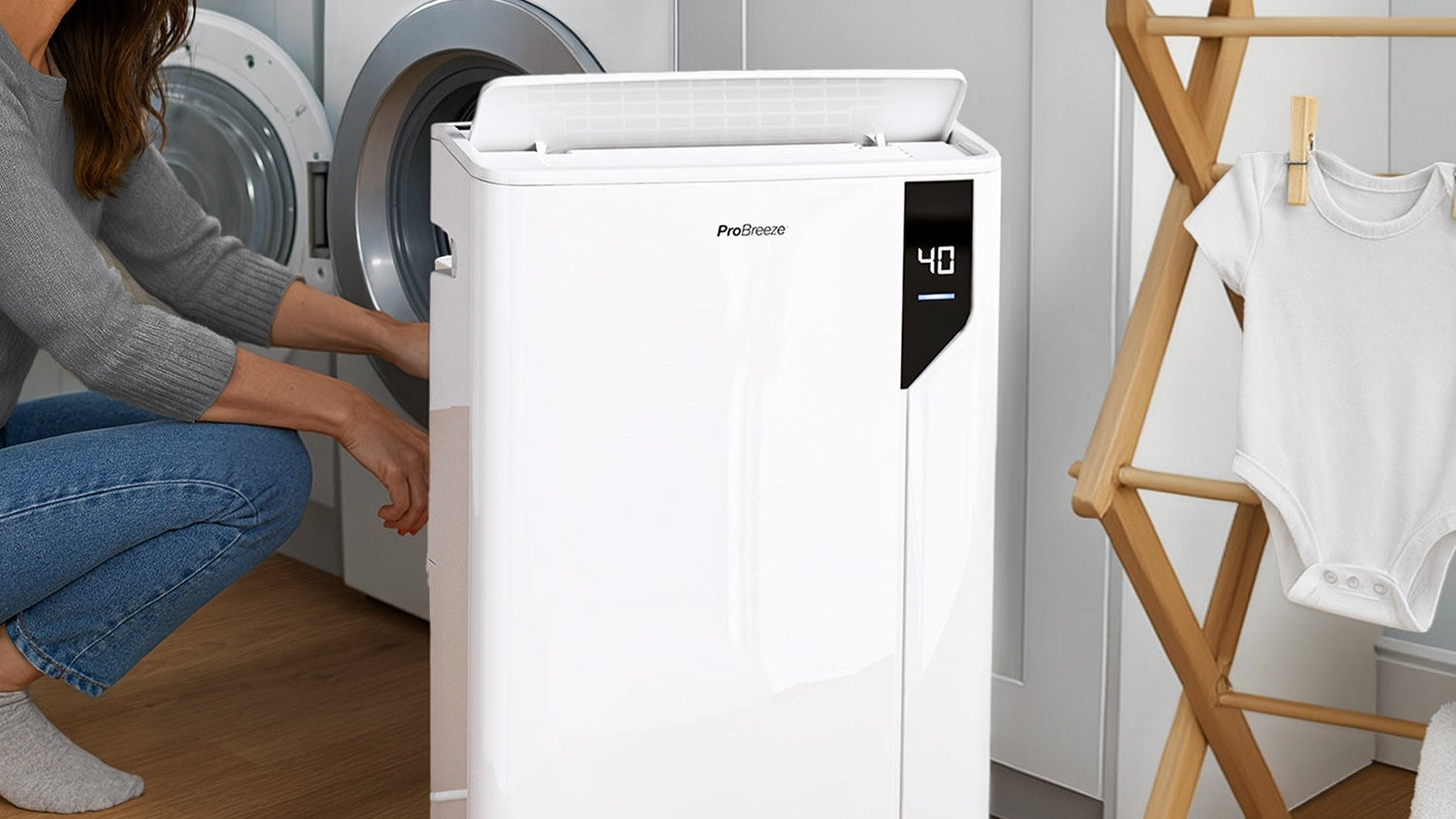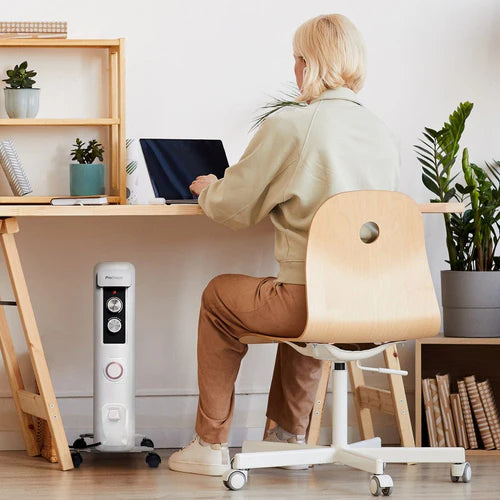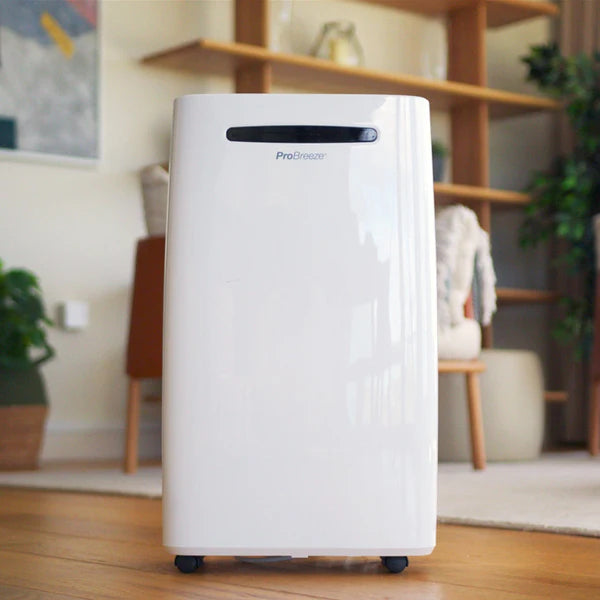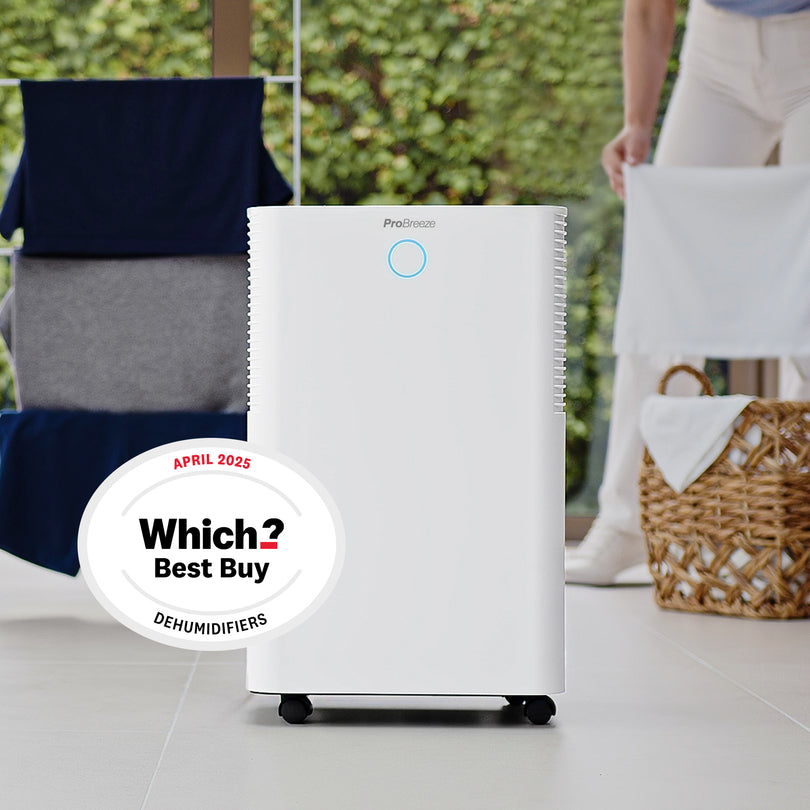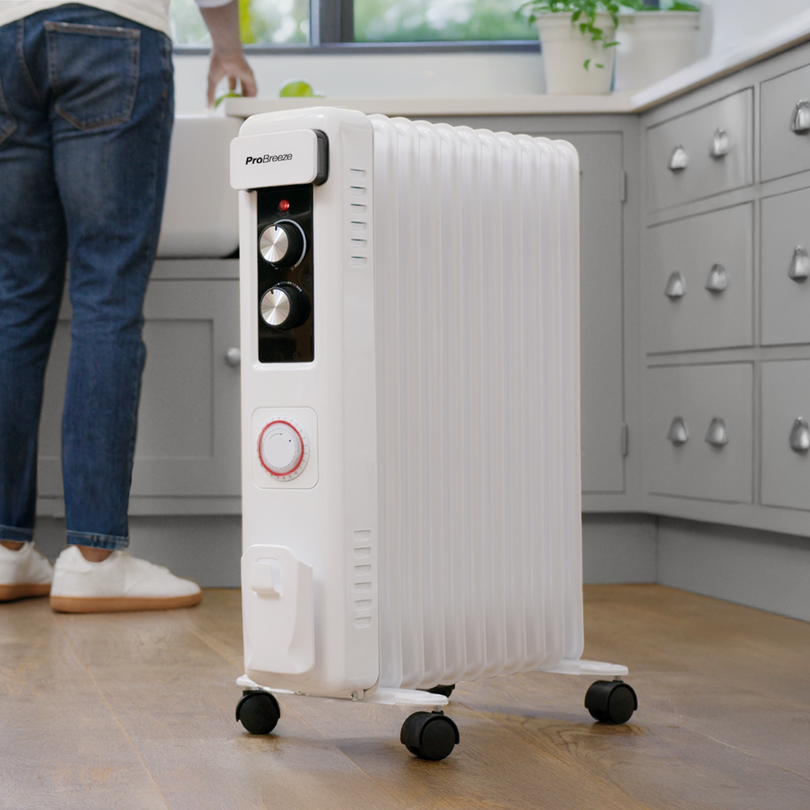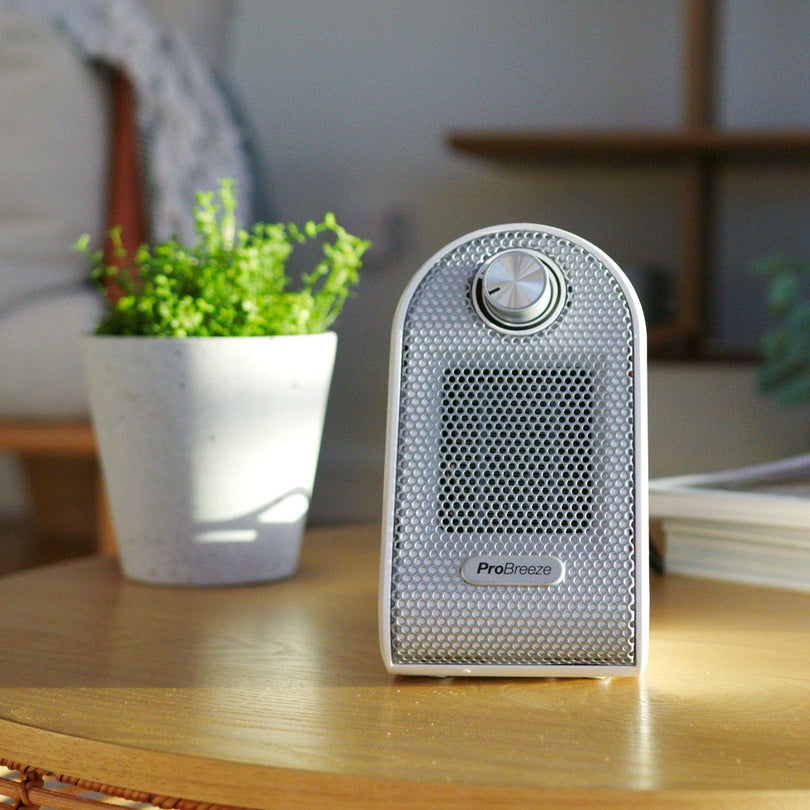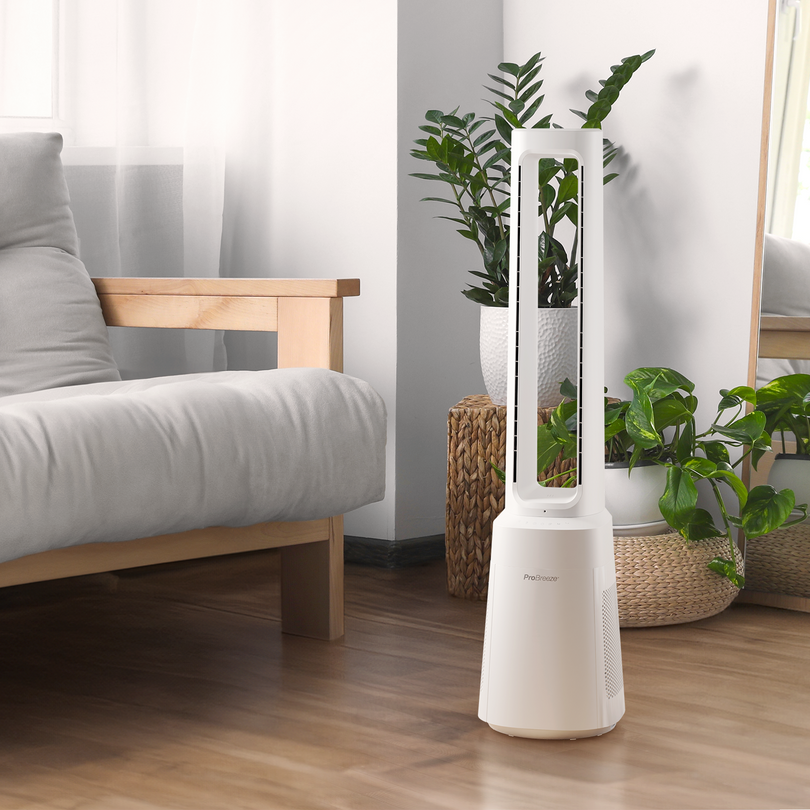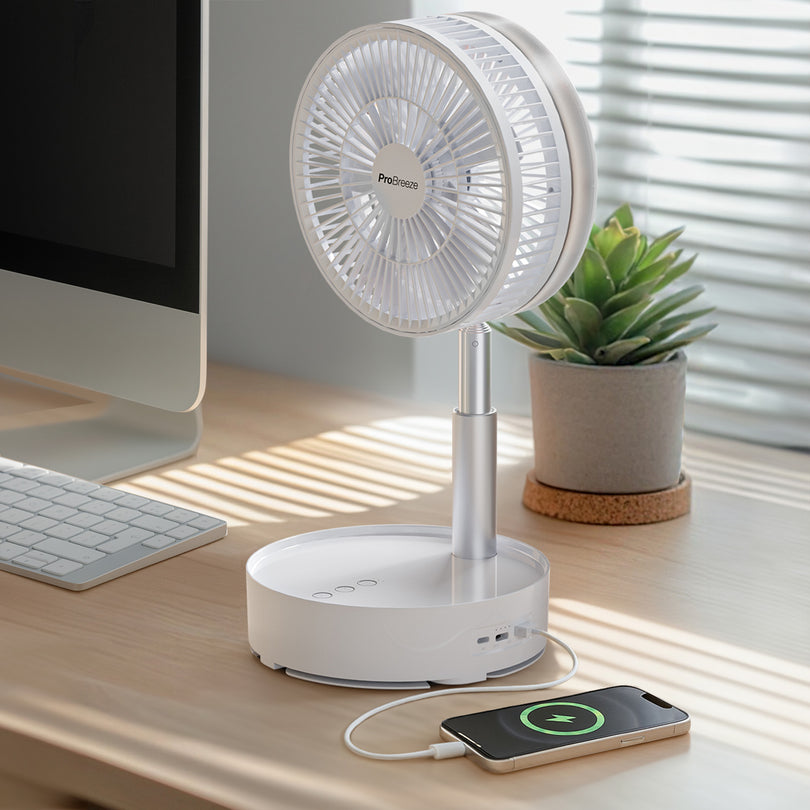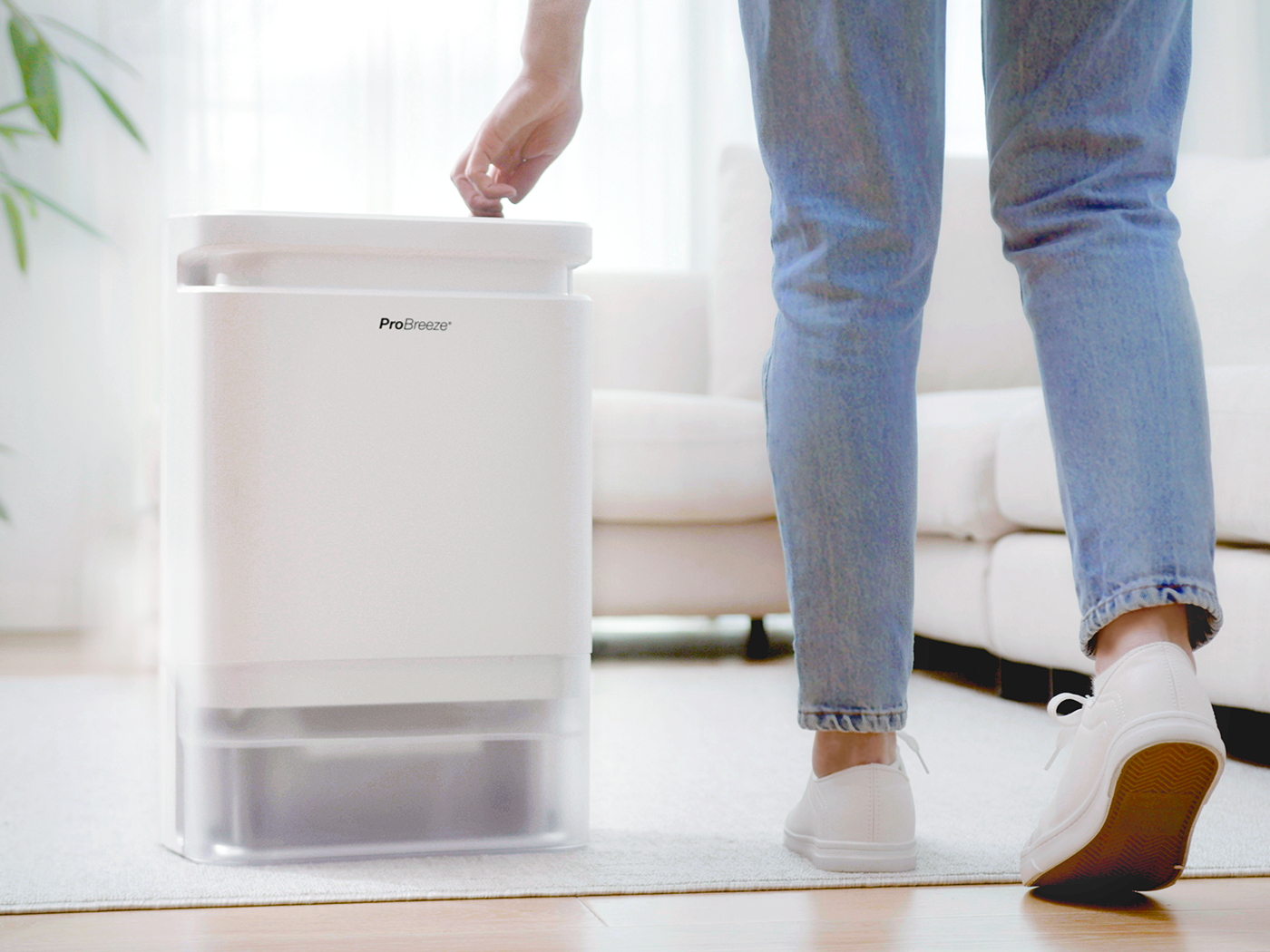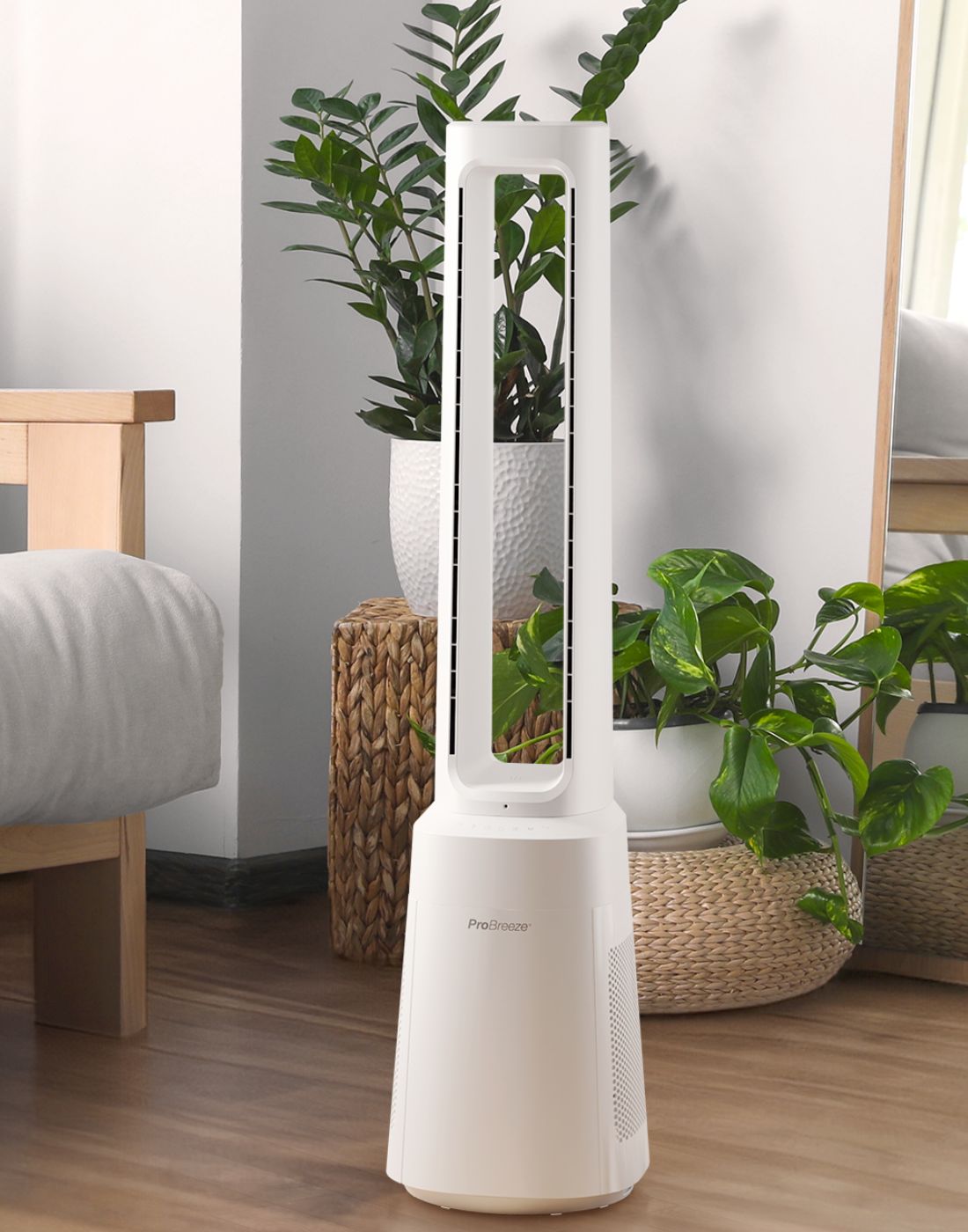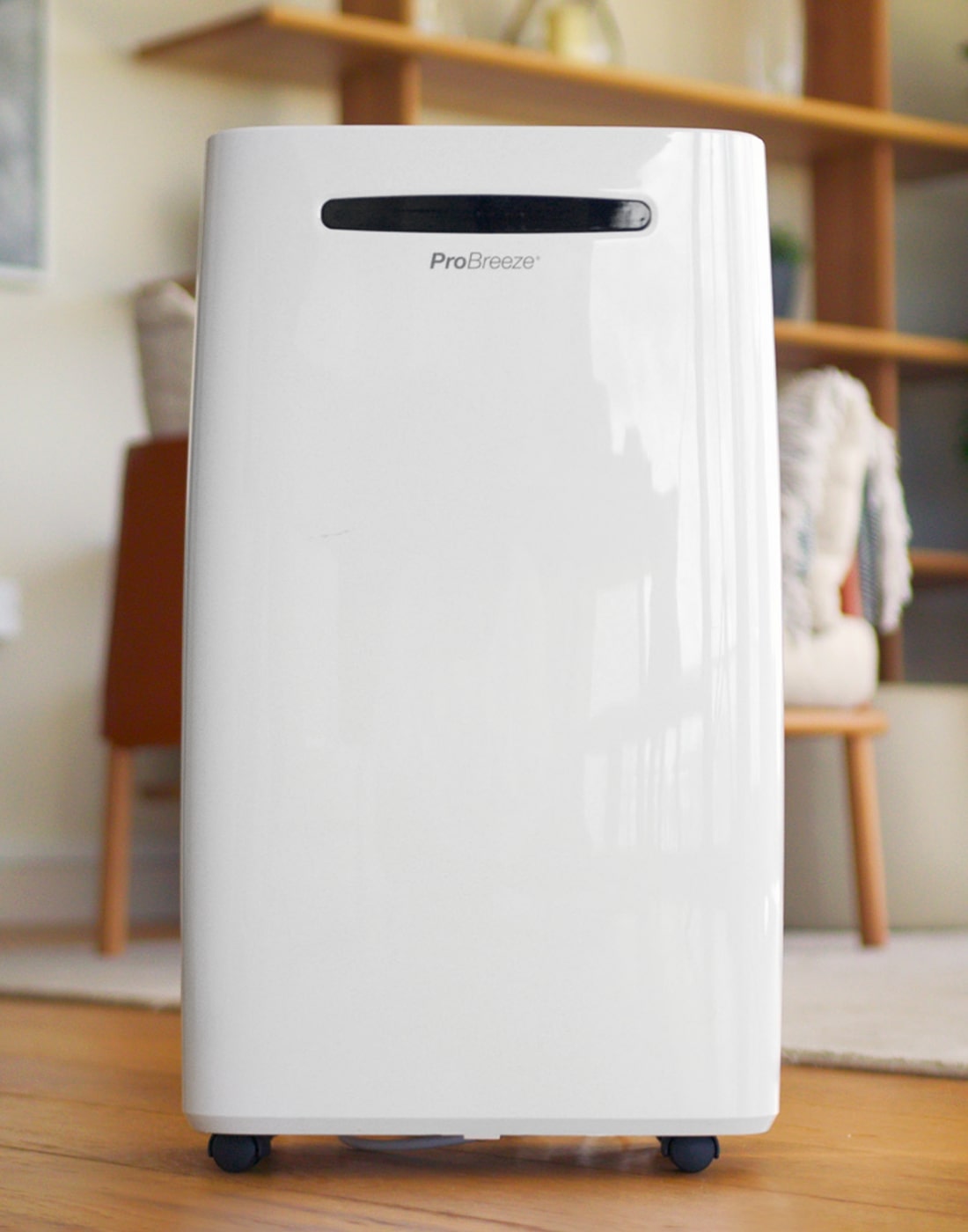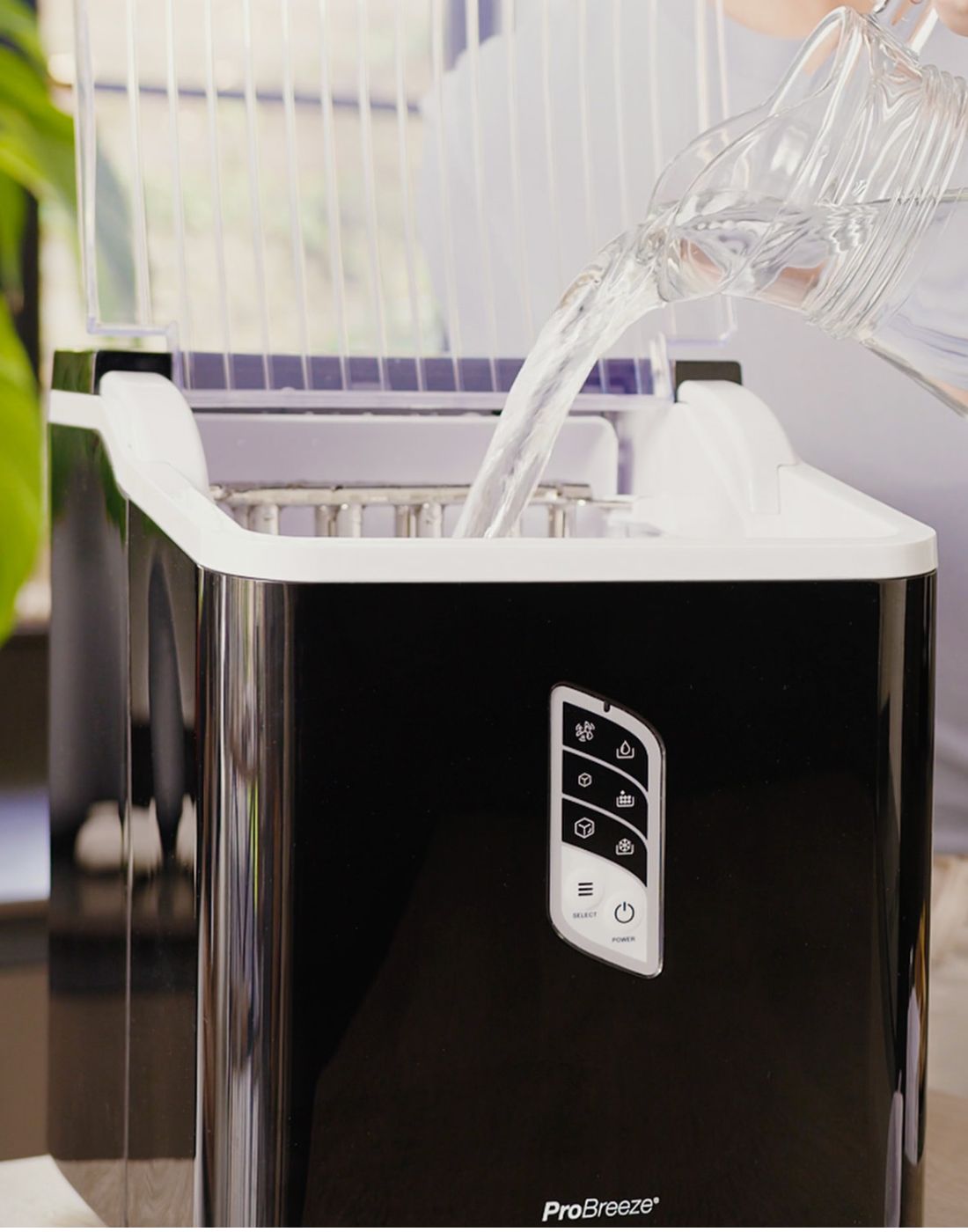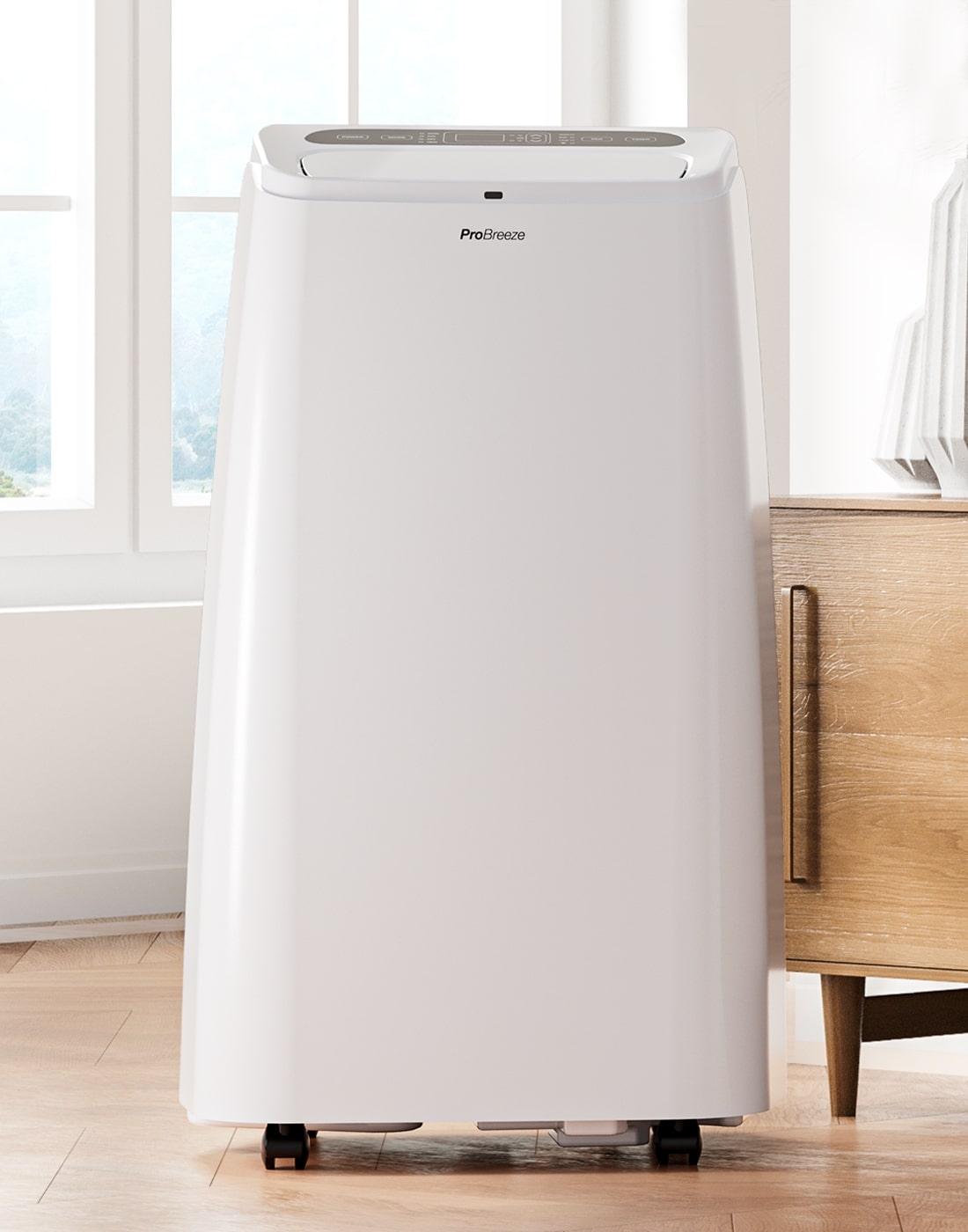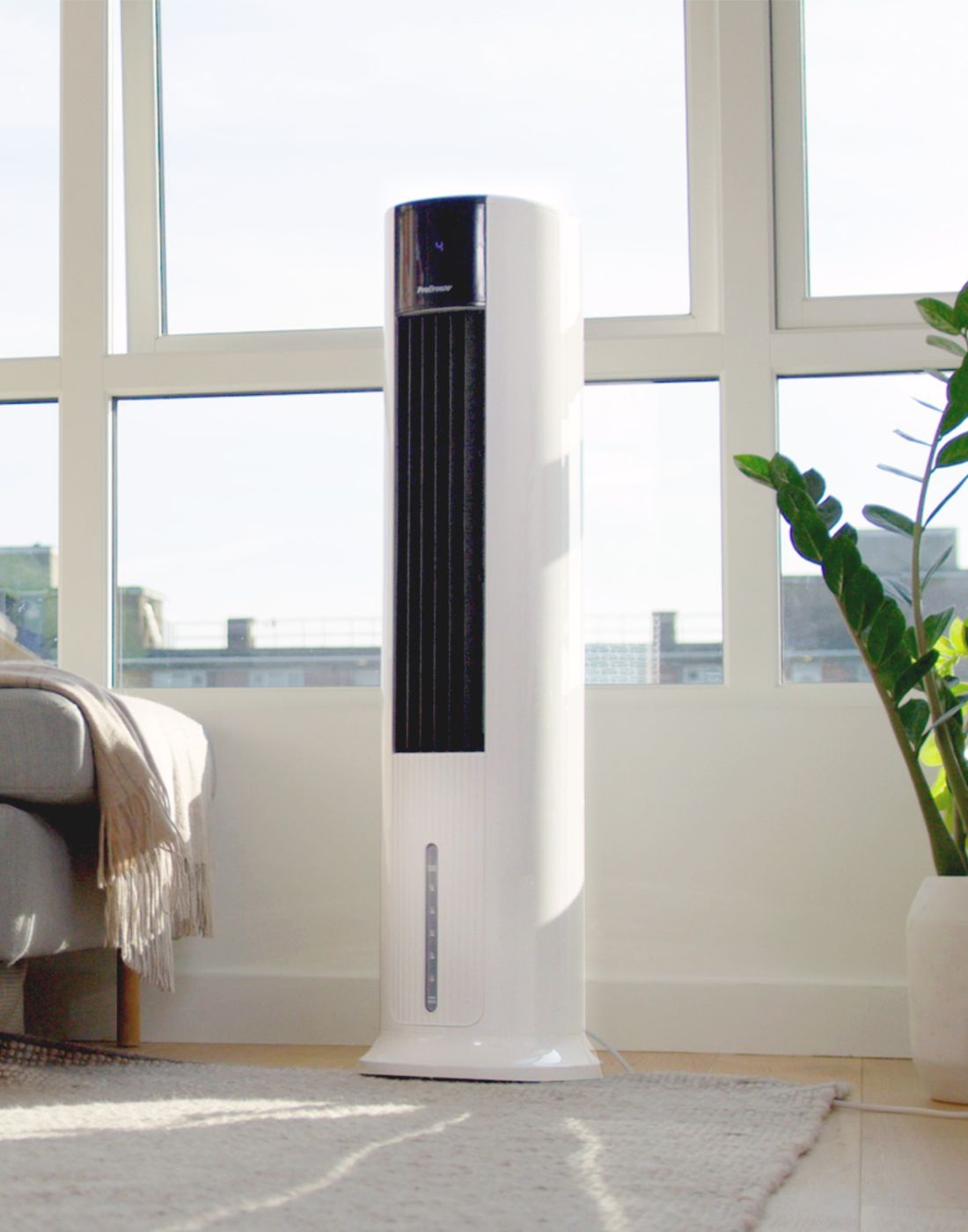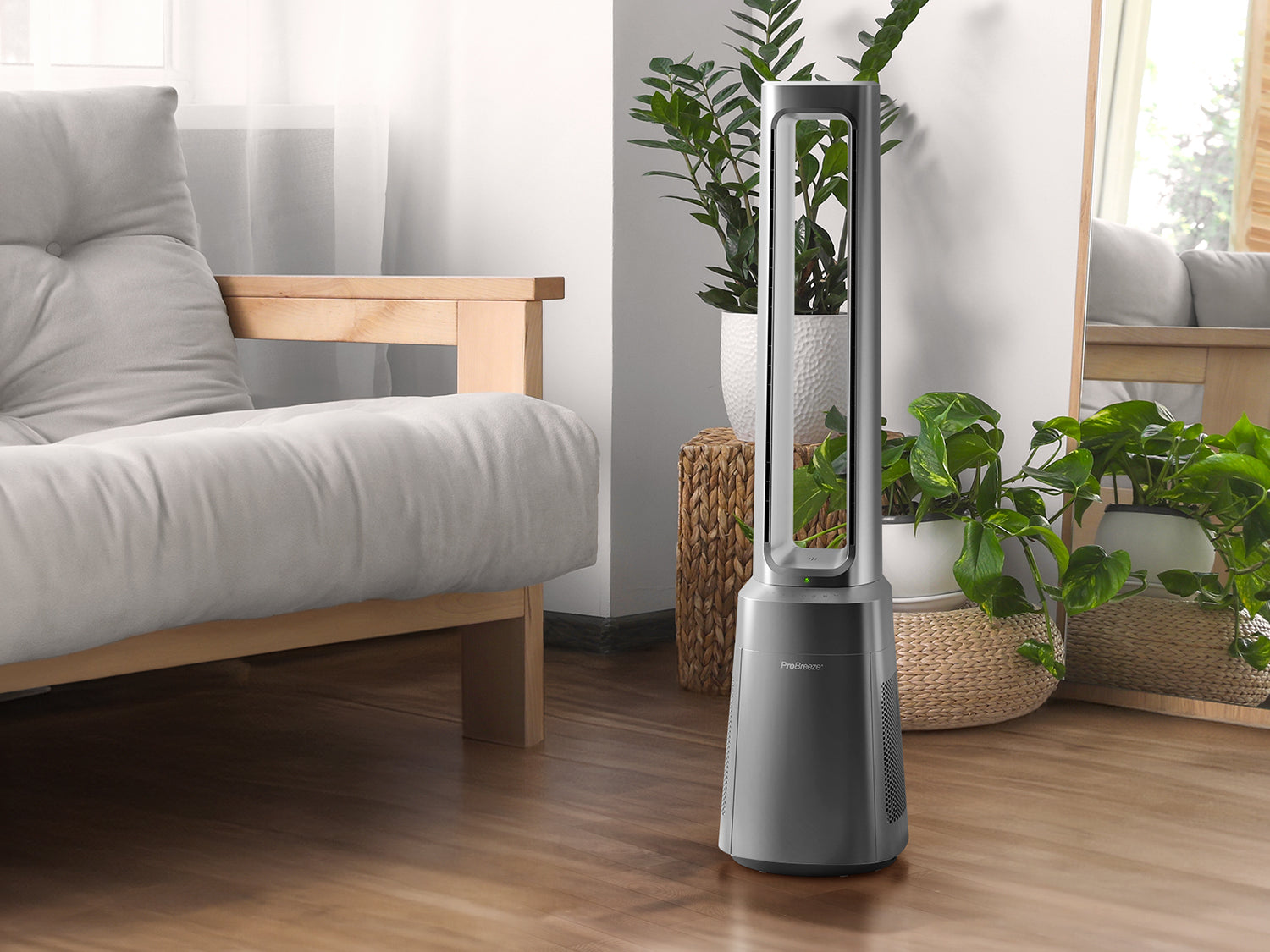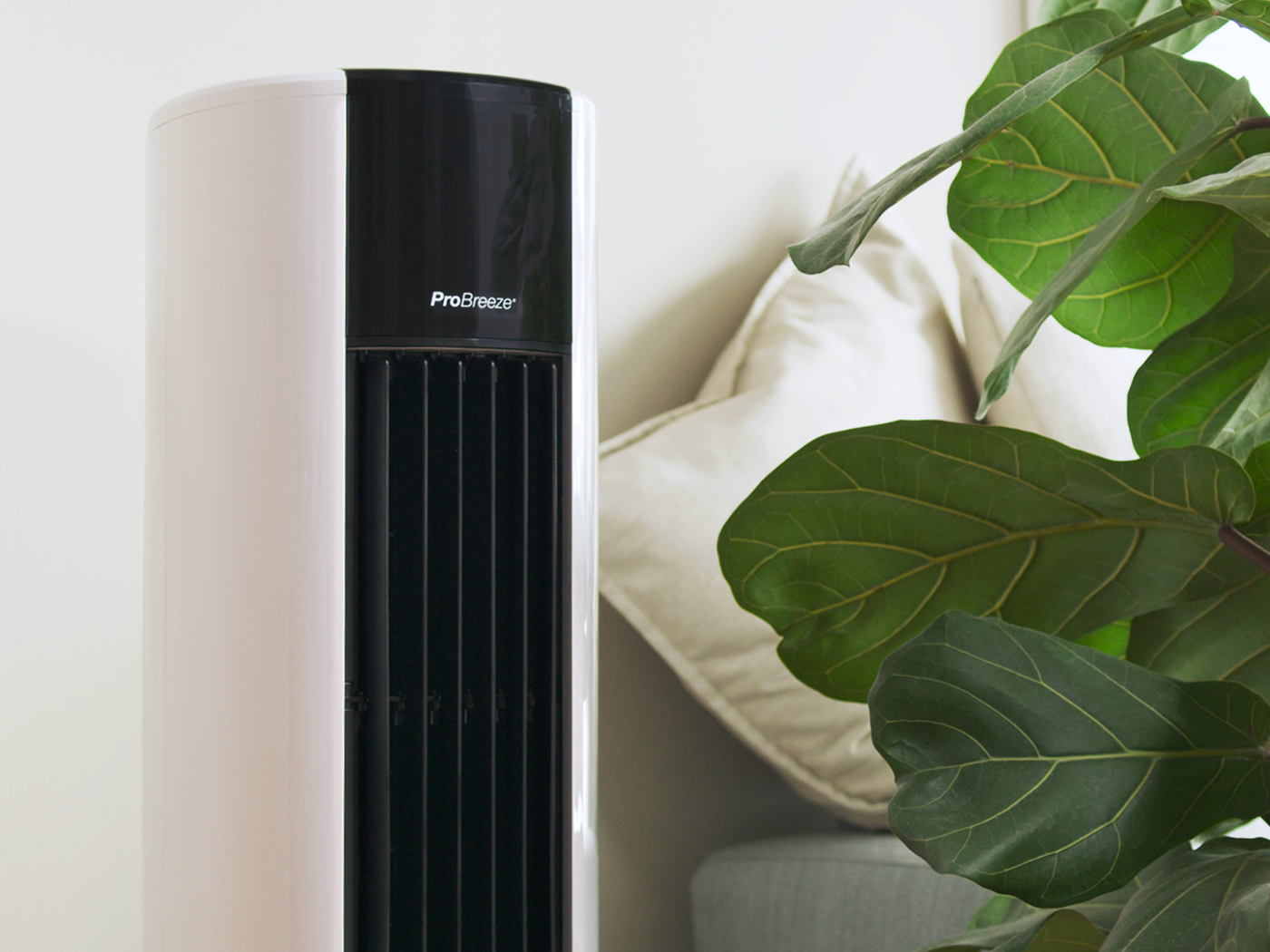You may be struggling with damp and think – bingo! I’ll just go online and buy a dehumidifier.
Then you discovered the sheer number of confusing (and sometimes expensive) options out there. You realise you have no idea how to choose a dehumidifier.
Never fear – we’re here to help you. Read our easy, actionable guide to buying a dehumidifier, and fix the damp problem in your home.
1. Introduction
Damp in your home! This is a huge problem in a cold, wet climate like the UK, and since warm air can hold more moisture, the use of central heating increases the chance of damp build-up too. With damp often comes black mould. This is not only extremely unsightly but also potentially dangerous for your belongings – and your health! The cause of this problem is usually too much moisture in the air (high humidity) and poor ventilation, which results in lots of condensation. High humidity results in problems like:
- Black mould
- Aggravated health problems (e.g asthma)
- Damage to your home and possessions
- Slow drying laundry
The necessities of everyday life, including heating, cooking, showering, ironing and drying clothes add to humidity! But you can’t stop doing these things.
What to do?
First, make sure there are no leaks inside your home. If there is a leak, this is probably the primary cause of your damp and you need a professional to fix it. A dehumidifier won’t help.
Detect a leak: Damp detectors are electronic devices that tell you if there is damp inside your walls. You can also just use your hand to see if the wall is damp. If you think the leak is coming from your water mains, contact your water supplier.
2. Do you need a dehumidifier?
Perhaps you are suffering from some allergies and sneezing or coughing a lot. Maybe you have noticed some signs of high humidity like:
- Condensation on windows.
- Mildew spots on the walls.
- A musty smell hanging around your home or in certain rooms.
- Watermarks in your basement.
- Rotting wood (beams or floors)
- Wallpaper peeling
If you notice any of these signs, you might have a problem with too much humidity. Basements, bathrooms, kitchens and attics are hotspots for high humidity.
NOTE: Mildew spots are different from mould. Mildew can be easily cleaned with standard cleaning materials and a scrubbing brush. Black mould is more insidious and can be more difficult and costly to remove.
These may be signs you need a dehumidifier, but not necessarily. The first step is to test the humidity in your home using a hygrometer, taking note of the visual signs.
Hygrometer: It’s a digital device that measures humidity in the air of a room. You can buy one for less than £10.
The ideal humidity level is between 30-50% in summer, or 30-40% in winter.
If your hygrometer shows humidity above 50%, try to remove the root cause of the humidity first. The prevention method depends on the severity of the problem, the time of year, and the location of the dampness.
If the problem is in the bathroom, the solution could be as simple as opening the window when you have a shower. If the room is a damp basement, simply heating the space might be enough to dry out the air. Tips for reducing humidity:
- Open windows (or turn on extractor fans) when cooking or showering to improve airflow
- Use lids on pans when boiling food to reduce steam
- Dry clothes outside or open windows when drying
- Remove houseplants as they release water vapour
- Heat the room with a radiator
- Make sure your washing machine (or tumble dryer) is not leaking and venting properly
- Open your bedroom window in the morning to release moisture from breathing in the night
- Dry clean your rugs as they collect moisture
- Ensure your home is sealed, plugging cracks with caulk or sealant
- Use charcoal or rock salt to absorb moisture
Some of these solutions may not be possible for you, or the problem is too severe. But it’s not the sort of problem you can comfortably ignore.
Black mould starts to grow at 50% humidity. Prevention is definitely better than cure when it comes to black mould. Buying a dehumidifier is a good way to prevent the conditions that lead to its growth.
A dehumidifier is a device that reduces the relative humidity in the air. Some trusted brands are Ebac, Delonghi and Meaco.
Next, learn how dehumidifiers work.
3. How does a dehumidifier work?
There are three main types of dehumidifier. The type you choose will depend on what your purpose is for the dehumidifier.
How do Peltier (thermo-electric) Dehumidifiers Work?
Peltier dehumidifiers work by pulling in damp air over the front of a cold heat sink. As the air passes over the cold surface, it condenses. The water released from the condensed air then drips down into the water tank and the dry air is released back into the room.
How do Compressor or refrigerant Dehumidifiers Work?
Refrigerant dehumidifiers (also known as compressor dehumidifiers) work in a similar way to your fridge. They use a fan to draw in air and pass it across extremely cold coils. Water condenses on the coils and drips into the water tank.
Finally, the air is reheated and pumped back into the room as warmer, drier air. This reduces the relative humidity in the atmosphere.
They differ from the peltier dehumidifiers above as they use a built-in compressor to cool down the coils as opposed to just the electric current from your mains. The compressor allows for coils of a much larger size to be chilled, and this larger surface means a lot more water can be condensed and collected.
How do Desiccant Dehumidifiers Work?
Desiccant dehumidifiers work by using a ‘desiccant’ chemical to ‘absorb’ moisture from the air. A fan draws the wet air into the dehumidifier where it is passed over the desiccant. The desiccant moisture absorber is held on a slowly rotating wheel.
Part of the wheel not being used is then heated up so that the moisture drips out into the water tank.
It then reheats the air and pumps the dried air back into the room. This reduces the relative humidity in the atmosphere.
That’s it!
Next, read on to decide what size dehumidifier you need to buy.
4. What size dehumidifier do I need?
We’re not talking about physical size here, but the amount of moisture a dehumidifier can remove from the air in 24 hours. Domestic dehumidifiers come in different sizes - anywhere from 250ml up to around 20 litres for a domestic model. If it sounds like a lot, you’d be surprised at how much water the air actually contains. The smallest size capacity dehumidifier would be around 0.25 - 1.5 litres. These are useful for a small single room, boat or caravan. The capacity size you need depends on:
- The size of the space you need to manage
- The relative dampness of the area
- The temperature of the environment
One thing to note is dehumidifier models are tested in ideal drying conditions and not in a real life environment. This means the true rate at which they extract water is probably slower than advertised. The rate also depends on environmental air temperature and humidity, so use it as a rough guide only. Increase in size if:
- You have a particularly large home.
- You want the dehumidifier to dry out a large room (choose one 10-20 litres)
- Conditions are wetter (stains on wall, condensation, wet floors)
It’s important to choose the right size because this impacts how much money you will need to spend buying a dehumidifier and the running costs of your unit.
| Environment Conditions | Less than 100 Square Feet | 150 Square Feet | 300 Square Feet | 500 Square Feet | 600 Square Feet | 1000 Square Feet |
| Mild Damp | 250 ml /day | 250 ml /day | 1 L/day | 10 L/day | 12 L/day | 14 L/day |
| Moderate Damp | 250 ml /day | 500 ml / day | 8 L/day | 12 L/day | 16 L/day | 18 L/day |
| Severe Damp | 5 L /day | 7 L/day | 12 L/day | 14 L/day | 18 L/day | 20 L/day |
| Drenched | 7 L /day | 8 L/day | 14 L/day | 16 L/day | 20 L/day | 25 L/day |
Choose the right size using this table. For peace of mind, we’d always recommend buying the largest dehumidifier you can for your space
5. Water tank size
Another feature of the dehumidifier you’ll need to consider is the size of its water tank. This determines how quickly it fills up and how regularly you need to empty it.
Your dehumidifier’s water tank collects the moisture it extracts from the air. The tank is usually smaller than its daily capacity.
If you buy the right size dehumidifier, you won’t need to empty the tank that often. Generally though, the larger the tank, the better – especially if you won’t be around much to empty it.
Compressor and desiccant dehumidifiers also tend to have continuous drainage hoses too. This allows them to operate constantly without worrying about the tank getting full.
6. Types of dehumidifier: pros and cons
One factor that affects the ideal size of your dehumidifier is the difference between the two main types of dehumidifier – compressor/refrigerant and desiccant. We explain which situations they’re suited to, and compare the pros and cons of each.
Compressor (Refrigerant)
Compressor dehumidifiers (also known as refrigerants) are usually designed to remove between 10L and 25L of moisture per day. These are ideal for dehumidifying areas of your home that are approximately room temperature and not too cold. In order for a refrigerant to work efficiently, the temperature in the room must be above the temperature of the coils in the dehumidifier. This means they will not work their best in a cold basement, garage, conservatory or caravan.
| Ideal temperature range: | 15-30°C |
| Suboptimal performance: | 10-15°C |
| Poor performance: | 5-15°C |
| Will not work: | Less than 5°C |
Pros
- The most common type of dehumidifier and widely available for purchase
- Collect large amounts of moisture in warm and humid conditions.
- More energy efficient than a desiccant dehumidifier above 15°C.
- They usually have a higher capacity than equivalent desiccant dehumidifiers.
- High performance dehumidifying an average home space at room temperature.
Cons
- They will only work in warmer and higher humidity conditions.
- They tend to be louder than a desiccant model.
- Poor performance in environments below 15°C.
Example use case: A three bedroom house with an average temperature of 21°C, using central heating in winter. You have a damp problem from household activities such as showering and clothes drying, and want to dry out the area very quickly.
Our best-selling compressor dehumidifiers:
20L Premium Dehumidifier with Special Laundry Mode
12L Low Energy Dehumidifier with Built-in Humidistat
Desiccant
Desiccants are recommended for colder environments like garages, conservatories and basements as they work at lower temperatures. Since they do not use a cold surface to condense and collect water like a compressor dehumidifier, they are much more efficient in cold environments. These tend to have a capacity of 7-12L.
Pros
- They work better in colder conditions.
- They are quieter than compressors.
- They are lighter than compressor models so they’re easier to move around.
Cons
- They are less energy efficient than compressor/refrigerant dehumidifiers
- They don’t work at higher temperatures.
- Performance starts to decrease above room temperature.
Example use case: The temperature of the area is very low (below 10°C) such as a cold garage in winter. In this case, a desiccant dehumidifier with a smaller capacity than a compressor (8L versus 20L) will significantly outperform a larger capacity compressor dehumidifier.
Peltier (thermo-electric)
Peltier models are suitable for smaller spaces and you should not expect them to work at the same efficiency as desiccant and compressor models. They have a smaller capacity of around 0.5L - 1.5L and work very well for the purpose they’re designed for. Like compressor dehumidifiers, they will not work well in conditions below 15°C. Ideal temperature range: 15°C or above
Pros
- Extremely energy efficient using very little electricity
- Work very well in small rooms or cupboards
- Quieter than both desiccants and compressors
- Require little to no maintenance
- Cheaper in price than desiccants and compressors
- Portable and lightweight
- They can be quickly moved with little to no interruptions in operation
Cons
- Not suitable for large rooms (above 220 square feet)
- Does not remove moisture as quickly as compressors and desiccants
- Do not work in very high humidity environments
- Poor performance below 15°C so not suitable for cold spaces
Example use case: A small space bedroom that suffers from window condensation and a few spots of mildew are starting to appear. The temperature is quite warm and does not usually fall below 15°C.
7. Energy efficiency and running cost
Dehumidifier Running Costs
You may be wondering, is a dehumidifier expensive to run?
Running your dehumidifier is likely to add anything between a few pounds to a couple of hundred pounds to your yearly electricity bill. It all depends on what type of dehumidifier you buy and how much you use it. For example, a peltier unit can cost as little as £5 per year to run, but of course they’re not as powerful as a compressor. Compressors are costlier to run than desiccants. At the same time, dehumidifiers also save you a lot of money. The financial benefits of having one are:
- No longer having to buy expensive anti-mould cleaning products.
- It reduces damage that you would otherwise have to pay to fix.
- They release warm air which may allow you to reduce your central heating.
Buying a dehumidifier saves on your electricity bill because:
- Dry air takes less energy to heat so you don’t need to use as much electricity.
- There is less need to open windows for ventilation, so you can eliminate energy wasting drafts (especially in winter).
- You can turn your thermostat down by at least one degree, because drier air feels warmer.
- Desiccants expel a lot of warm air so can sometimes be used in the same way as a heater.
As long as you use your dehumidifier efficiently and only when you need it, you’re likely to save money on overall costs – or at least, break roughly even. Here are approximate energy consumption amounts for the three different types of dehumidifier:
| Type | Power Rating* | Per Hour | Per Day † | Per Week |
| Peltier - 500ml | 23W | £0.01 | £0.04 | £0.28 |
| Compressor - 10L | 230W | £0.04 | £0.48 | £3.36 |
| Desiccant - 8L | 650W | £0.10 | £1.20 | £8.40 |
* approximate power rating across the industry.
† based on 12 hours a day using the Average rate of 15.41p/kWh for a unit of electricity.
Dehumidifier Energy efficiency
Investing in a dehumidifier has potential to save you money, but it’s not a one-size-fits-all solution. You could end up wasting money if you don’t use it correctly. Increasing energy efficiency reduces running costs, and it’s better for the environment too. So what should you do to increase energy efficiency?
- Lower the humidity in your home by using the methods listed towards the top of this guide. This will relieve the amount of work the humidifier has to do.
- Proper maintenance such as cleaning the filter will also boost energy efficiency.
- Buy a model that’s rated as energy efficient. The phrase “energy efficient” is used liberally by marketers and may not have much relation to reality.
We recommend looking at the energy factor of your dehumidifier, which is the number of litres of water it removes from the air per kilowatt hour (kWh) of electricity used. The more it removes per kWh, the more efficient your unit is.
8. Key features and functionalities
So you’ve found a dehumidifier that’s the right size, and it’s energy efficient to. It’s now time to get down to the details. Dehumidifiers have a number of features that you should acquaint yourself with. If you’re likely to need any of these features, be sure to choose a model that includes them.
- Mobility – most people want to move their dehumidifier around so make sure it has a handle and caster wheels if it is a large unit (more than 8L)
- Adjustable humidistat – to allow you to set your ideal humidity level.
- Inbuilt hygrometer – to automatically detect the humidity of the air which can be used to determine switch itself on or off.
- Automatic shutoff – to detect when the ideal humidity has been reached (or the water tank is full) and shuts down the unit.
- Auto-reset – in case there is a power outage or you unplug it, the system remembers your settings for the next time you use it.
- Defrost mode – this stops the dehumidifier freezing up in low temperatures.
- Noise level – Dehumidifiers are sold with a noise level rating so you know how loud it is when it’s operating.
- Continuous drainage – some dehumidifiers can be sold with a inbuilt hose to drain the water tank, removing the need for you to empty it.
For example, if you will not be around much to turn off the dehumidifier, automatic shut-off is essential. Similarly, if you want it to run when you’re not there to empty the tank, such as in a basement, choose one that has continuous drainage.
9. Best way to use a dehumidifier
Now you’ve got your dehumidifier, what’s the best way to use it?
If you are drying out a room for the first time, you’ll need to use your dehumidifier for longer. That could be anything from 8-hours, to 24-hours, to several days depending on the humidity of the area and capacity of your dehumidifier.
Once you have reached a target baseline humidity (eg 50% humidity), you will only need to use it for 2-4 hours per day to maintain that level. You will not necessarily need it at all times of the year. It depends on the conditions of your home. If your humidifier features an adjustable humidistat then as long as you set it to your desired humidity level, it should only turn on if the humidity level rises above your target.
Get ready to use your dehumidifier
- Vacuum your home beforehand to diminish the chance of spreading aggravating dust particles, or clogging the vent of your dehumidifier.
- Keep doors and windows closed during use.
- Block off additional sources of moisture (like the toilet).
- If your dehumidifier is brand new and it’s a compressor model, leave it to stand for an hour to allow the refrigerant inside to settle.
Operate your dehumidifier correctly
- Make sure the unit is stable and balanced on an even surface.
- If you can, position centrally in the room to ensure optimal airflow.
- If you’re using it to dry out your whole home at once, place it in the hallway or landing.
- Dehumidifiers work best when they have space around them (at least six inches on all sides). Do not place it against a wall.
- Alternatively, if you want to specifically dry out damp walls or condensation on windows, place the dehumidifier as close as possible to the source of the problem.
- Plug directly into the mains (Avoid using an extension lead).
And what is the best setting to have a dehumidifier on? Set it to your desired humidity, which should be between 30-50% in summer, and 30-40% in winter.
Maintaining your dehumidifier
All
- Turn off and unplug before maintenance.
- Empty the tank after each use.
- Clean the tank with warm water and washing up liquid every two weeks to prevent mould growth.
Compressors
- Check for dust on the coils and remove with a cloth to keep your dehumidifier efficient.
- Check the coils for ice build-up and raise the position of the dehumidifier if you find any (it means the temperature is too cold).
Desiccants
- Remove the air filter and clean with soap and warm water when dust starts to build up – at least every two weeks in regular use.
- Use a vacuum cleaner to clean the filter if it is antibacterial.
Peltiers
Clean the air vents with a soft brush to prevent dust build up.
10. Servicing, maintenance & warranties
A dehumidifier is for life, not just for Christmas. They need regular maintenance. Some things you will need to do are:
- Reading the instructions is crucial for setting up and maintaining your dehumidifier correctly.
- The instructions will tell you the best way to clean the air filter regularly and how to wash the tank.
If you take care of your dehumidifier properly, it should last for a long time. Sometimes, though, things do go wrong.
As with all domestic products, the manufacturer or retailer should provide a warranty with your dehumidifier. If anything goes wrong within this period, they should repair or replace it free of charge.
You might need to keep the proof of warranty, the receipt, and possibly the original packaging for the product. Put it somewhere safe so you’ll be able to find when you need it.
Normally, the warranty is for 12 months. Sometimes you may have the option to purchase extended warranty, so you’re covered for longer.
11. Your budget & your needs
Many people can be put off buying a dehumidifier because they attribute it to being a large investment.
If you are worried about the cost and only need to dry a small space, mini dehumidifiers typically cost between £30-60. These are referred to as peltier or thermo-electric models and will extract anything from 200ml to 1 litre per day. They also use very little electricity - making them cheap to run.
Larger dehumidifiers that use either a compressor or desiccant typically cost between £100-£250. The more powerful they are, the more they tend to cost (though not always, which is why you need to do your research).
If you buy the right size dehumidifier for your needs, you will make the most of your budget. Remember, buying the right dehumidifier for you now will save you money through reducing damp, and drying/heating the air, all of which can be costly to deal with if left untreated
To conserve energy and lighten the load on your wallet, choose your dehumidifier on the basis of the size, dampness and temperature of the space you need to dry out.
12. Recalled dehumidifier list
It’s important to note that dehumidifiers can pose a fire risk if faulty. Some models have been recalled due to overheating.
No models should be on the market that have been recalled, but beware of these models if you’re thinking of buying one second hand.
| Brand | Model Number | Year Recalled |
| Argos 10 L | DHMD102 | 2016 |
| Dimplex | DXDH10N / DIMOC - DH212 | 2016 |
| B&Q Airforce 20 L | BQDC20 | 2014 |
| Boots Mini Dehumidifier | 47-15-187 | 2005 |
| DH30 Drydamp | 007001 to 014030 | 2002 |
| Ebac 880e | starting with 11489 | 2000 |
